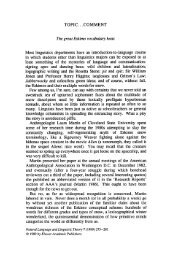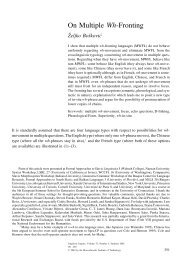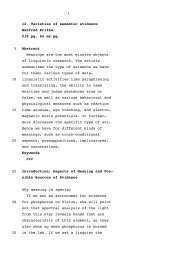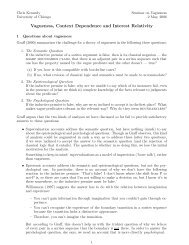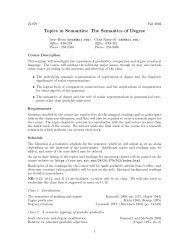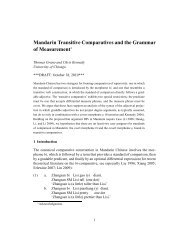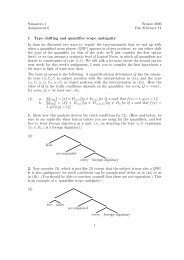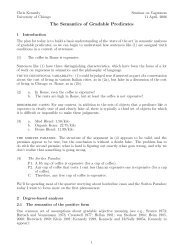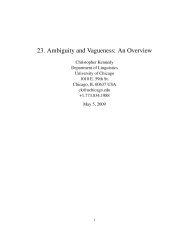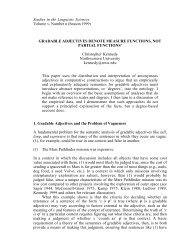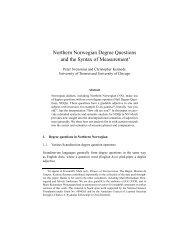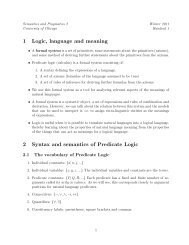On the natural history of negative polarity items - Syntax, Semantics ...
On the natural history of negative polarity items - Syntax, Semantics ...
On the natural history of negative polarity items - Syntax, Semantics ...
Create successful ePaper yourself
Turn your PDF publications into a flip-book with our unique Google optimized e-Paper software.
Manfred Krifka<br />
(6) C + QUs,a(') = {$C} {cC | p'[$C + ASSa,c(p)] % c}<br />
In contrast, in a speech act question <strong>the</strong> question operator applies to ano<strong>the</strong>r speech act, as follows:<br />
(7) C + QUESTs,a(Aa,s) = {$C} C + Aa,s<br />
This restricts <strong>the</strong> commitment space in such a way that <strong>the</strong> act Aa,s is enforced as <strong>the</strong> next move. As with o<strong>the</strong>r<br />
speech acts, a can reject this, or accept it, in which case a must perform Aa,s. It can be derived that s performs<br />
such an act when uncertain whe<strong>the</strong>r <strong>the</strong> effects <strong>of</strong> Aa,s already hold or should hold in <strong>the</strong> commitment space<br />
C, which leads to <strong>the</strong> conversational implicature that s has at least slight doubts whe<strong>the</strong>r a will perform Aa,s.<br />
While QU is expressed syntactically (e.g., by AUX inversion), QUEST can be expressed prosodically (by<br />
rising intonation). It can apply to assertions (cf. Gunlogson 2002 for “declarative questions”), but also to a<br />
wide variety <strong>of</strong> o<strong>the</strong>r speech acts, e.g. to commands:<br />
(8) a. There is a vegetarian restaurant around here?<br />
b. A: Open <strong>the</strong> window! B: Open <strong>the</strong> window? But it’s cold around here!<br />
In addition, <strong>the</strong>re is a “incredulity” prosody, optionally accompanied by an incredulous-looking face<br />
(Crespo-Sendra e.a. 2010) that conventionally implicates that s does not believe that <strong>the</strong> speech act in question<br />
can be performed by a. The corresponding operator will be rendered as QUEST-I.<br />
Speech act questions can also apply to (regular) questions, which is especially clear with incredulity prosody:<br />
(9) A: Is Butan in Africa? B: Is Butan in Africa?? Everyone knows that it’s in Asia!<br />
In addition, I assume that QUEST(-I) can apply to assertions and trigger AUX inversion just as QU. The following<br />
syntactic structures indicate one way how this can be captured; here, ForceP stands for <strong>the</strong> syntactic<br />
category corresponding to speech acts (cf. Rizzi 1997).<br />
(10) a. [ForceP QU [Force& [Foce0 is] [IPQ <strong>the</strong>re _ a vegetarian restaurant around here]]]<br />
b. [ForceP QUEST(-I) [Force& [Force0 is] [ForcePASS [IP <strong>the</strong>re _ a vegetarian restaurant around here]]]<br />
In (a), s restricts C such that its root $C is followed by an assertion by a <strong>of</strong> one <strong>of</strong> <strong>the</strong> propositions in <strong>the</strong> set<br />
{‘<strong>the</strong>re is a v.r.’, ¬‘<strong>the</strong>re is a v.r.’}. In (b), s restricts C such that $C is followed by a’s assertion <strong>of</strong> ‘<strong>the</strong>re is a<br />
v.r.’; this comes with <strong>the</strong> implicature (conversational with QUEST, conventional with QUEST-I) that s believes<br />
that a will reject this move. Hence, we explain <strong>the</strong> bias <strong>of</strong> s towards ¬‘<strong>the</strong>re is a v.r.’. As (b) is distinct<br />
from (a) only with <strong>the</strong> prosody <strong>of</strong> QUEST-I, we get this reading reliably only with incredulity prosody.<br />
In <strong>the</strong> case <strong>of</strong> “high” negation, I assume denegation <strong>of</strong> <strong>the</strong> embedded assertion:<br />
(11) [ForceP QUEST(-I) [Force& [Force0 is] [NegP n’t [ForceP ASS [IP <strong>the</strong>re _ a veg. restaurant a round here]]]]]<br />
(12) C + QUEST(-I)s,a(~ ASSa,s(‘<strong>the</strong>re is a v.r.’)) = {$C} C + ~ ASSa,s(‘<strong>the</strong>re is a v.r.’)<br />
That is, s restricts <strong>the</strong> acts <strong>of</strong> a to <strong>the</strong> denegation <strong>of</strong> <strong>the</strong> assertion by a <strong>of</strong> ‘<strong>the</strong>re is a v.r.’. Again, this comes<br />
with <strong>the</strong> (conversational or conventional) implicature that s believes that a will reject this move, which explains<br />
<strong>the</strong> bias towards ‘<strong>the</strong>re is a v.r.’ In this case, <strong>the</strong> operator QUEST (without incredulity prosody) will<br />
achieve <strong>the</strong> reading as well, as asking for a negated proposition is dispreferred.<br />
The presentation will conclude with a short discussion <strong>of</strong> question tags (as in isn’t <strong>the</strong>re? vs. is <strong>the</strong>re?),<br />
which will be treated as elliptical questions adding <strong>the</strong>ir bias to <strong>the</strong> preceding assertion.<br />
AnderBois, Scott. 2011. Issues and alternatives. Doctoral dissertation. University <strong>of</strong> California at Santa Cruz. — Büring, Daniel & Christine Gunlogson.<br />
2000. Aren't positive and <strong>negative</strong> polar questions <strong>the</strong> same? LSA Annual meeting. — Cohen, Ariel & Manfred Krifka. 2011. Superlative quantifiers<br />
as modifiers <strong>of</strong> meta-speech acts. The Baltic International Yearbook <strong>of</strong> Cognition, Logic and Communication 6,<br />
http://<strong>the</strong>balticyearbook.org/journals/baltic/article/view/1578/1224 — Crespo-Sendra, Verònica et al. 2011. Perceiving incredulity: <strong>the</strong> role <strong>of</strong> intonation<br />
and facial gestures. Phonetics & Phonology in Iberia 2011. — Gunlogson, Christine. 2002. Declarative questions. SALT XII,, 124-134. — Hare,<br />
R. M. 1970. Meaning and speech acts. The Philosophical Review 79: 3-24. — Ladd, D. Robert. 1981. A first look at <strong>the</strong> semantics and pragmatics <strong>of</strong><br />
<strong>negative</strong> questions and tag questions. CLS 164-171. — Rizzi, Luigi. 1997. The fine structure <strong>of</strong> <strong>the</strong> left periphery. In: Haegeman, Liliane, (ed), Elements<br />
<strong>of</strong> grammar. Dordrecht: Kluwer, 281-337. — Romero, Maribel & Chung-hye Han. 2002. Verum focus in <strong>negative</strong> yes/no quesitons and Ladds<br />
p / ¬p ambiguity. SALT XII, 204-224. — Romero, Maribel. 2005. Two approaches to biased yes/no questions. WCCFL 24, 352-360. — Reese, Brian<br />
J. 2005. The meaning and use <strong>of</strong> <strong>negative</strong> polar interrogatives. Empirical Issues in <strong>Syntax</strong> and <strong>Semantics</strong>. Paris: 331-354. — van Rooy, Robert &<br />
Marie !afá"ová. 2003. <strong>On</strong> polar questions. <strong>Semantics</strong> and Linguistic Theory (SALT) 13. Ithaca, NY: Cornell University, CLC Publications, — Venhuizen,<br />
Noortje Joost. 2011. Negation in questions. MSc Thesis. University <strong>of</strong> Amsterdam.



